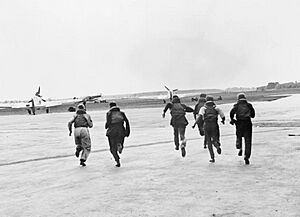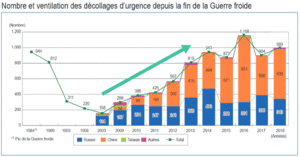Scrambling (military) facts for kids

In military aviation, scrambling means getting military aircraft ready and into the air very, very quickly! It's usually done when there's an immediate threat, like needing to stop enemy planes. Think of it like a superhero alarm, but for fighter jets!
Contents
What Was Scrambling in the Battle of Britain?
The word "scrambling" became famous during the Battle of Britain in World War II. This was when Royal Air Force (RAF) pilots and their fighter planes had to be ready to fly at a moment's notice.
How Did Scrambling Work?
Giant radar stations, like the Chain Home system, would spot enemy aircraft. This information then went to RAF Fighter Command's special system, called the Dowding system. This system helped manage all the air defenses.
Once a decision was made to stop the enemy planes, a phone call would go to the chosen fighter squadron's airfield. There, a loud bell would ring to tell the pilots waiting by their aircraft that it was time to scramble!
Why Was Speed Important?
Every minute lost before taking off was a big advantage for the enemy. The faster a pilot could get into the sky, the more height they could gain. Being higher than the enemy planes gave them a better position for fighting.
Secret Codes for Pilots
Pilots received important information when they scrambled. This included where the enemy planes were and how high they were flying.
- "Angels" with a number meant the height of the aircraft. For example, "Angels One Five" meant planes were at 15,000 ft (4,600 m).
- Unknown aircraft were called bogeys.
- Known enemy planes were called bandits.
Scrambling During the Cold War
During the Cold War, many air forces in NATO (a military alliance) kept their crews on high alert in Europe. They would scramble whenever another country's planes entered their airspace without permission.
From Bells to Radios
Over time, the old bell-ringing method for scrambling was replaced. Newer electronic radio systems made communication much faster and clearer. However, many fighter squadrons still keep a bell in their squadron bar today. This is a fun tradition that reminds them of the Battle of Britain. If someone rings the bell, they usually have to buy drinks for everyone there!
Quick Reaction Alert (QRA)
Both interceptor planes (designed to stop other aircraft) and nuclear bomber planes were kept on "Quick Reaction Alert" (QRA). This meant crews stayed very close to, or even inside, their aircraft. They had to be ready to take off in a very short time. Usually, this was about 15 minutes, but during very tense times between countries, it could be as little as two minutes!
See also
- Combat readiness
- Minimum Interval Takeoff
- Interceptor aircraft
- Ground-controlled interception
- Glossary of RAF code names


